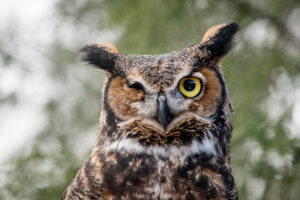Superb Owl Sunday: 8 Fun Facts About Owls
February 9, 2024
Posted by Lake Erie Nature and Science Center

Owls are some of the most fascinating creatures in Ohio. Their mysterious nature, charismatic expressions and recognizable calls have sparked interest for centuries.
In honor of Superb Owl Sunday, here are fun facts to celebrate these magnificent birds of prey.
Ohio is home to several owl species.
Eight owl species reside in Northeast Ohio throughout the year. Three of the most common include the Great Horned Owl, the Barred Owl and the Eastern Screech-Owl.
Their eyes are not true “eyeballs”.
Owls have large, tube-shaped eyes that are completely immobile. Their retinas contain many rod cells for excellent night vision and depth perception for hunting.
Owls can rotate their necks 270 degrees
While it is a common misconception that owls can rotate their heads 360 degrees, they are capable of turning their heads 270 degrees in either direction. This flexibility helps them look around since their eyes are fixed in their sockets.
Many owls have asymmetrical ears.
Some species of owls have one ear opening higher than the other. This unique adaptation allows the owl to determine what height and direction a sound is coming from.
Owls are skilled hunters.
Owls are covered in extremely soft feathers that provide insulation during cold winter weather. Their feathers allow for silent flight and the ability to strike quietly in pursuit of prey, which include animals several times heavier than themselves.
Owls have powerful talons.
Like eagles and hawks, owls are birds of prey, which means they use sharp talons to hunt other animals. An owl can grip with either three toes in front and one behind, or with two toes forward and two behind. When clenched, a Great Horned Owl’s strong talons require a force of 28 pounds to open.
Owls often swallow their prey whole.
Owls swallow their prey whole or in large pieces, but cannot digest fur, teeth, bones, or feathers. These pieces are regurgitated, typically once a day, in the form of a pellet.
Not all owls hoot.
Great Horned Owls and Barred Owls are vocal birds that make the traditional hooting sounds that you may already associate with owls (including the Barred Owl’s famous call, “Who cooks for you? Who cooks for you all?”). Despite their name, Eastern Screech-Owls do not screech but make sounds of whinnies and soft trills.
Interested in learning more about native owl species? Join Lake Erie Nature & Science Center on Friday, February 23 at 6 p.m. for its annual Owl Prowl. Enjoy up close encounters with the Center’s resident owls, experience nocturnal sights and sounds in the planetarium, follow clues to solve the mystery word on an owl scavenger hunt, and head outdoors on a hike in hopes of spotting or hearing wild owls in the surrounding forest. Tickets: $15/person. Learn more and register at www.lensc.org/family-programs. 28728 Wolf Road, Bay Village, OH 44140.
Sources: Lake Erie Nature & Science Center, Cornell University, and National Audubon Society.

